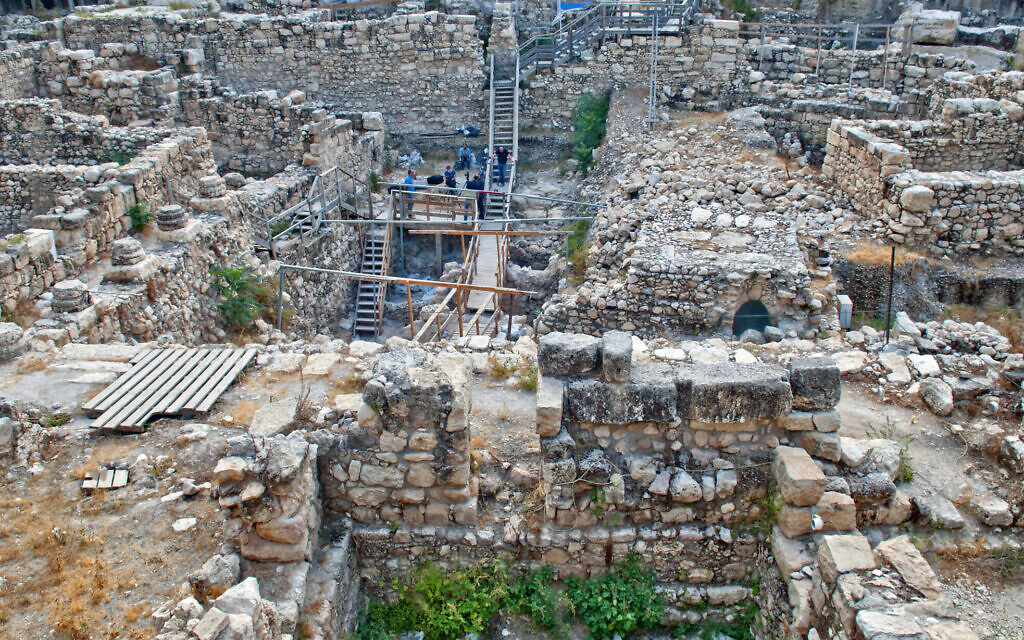Monday, 10 August 2020
Burnt remains from 586 BCE Jerusalem may hold key to protecting planet
A new analysis of 1st Temple-era artifacts, magnetized when Babylonians torched the city, provides a way to chart the geomagnetic field – physics’ Holy Grail – and maybe save Earth
The Bible and pure science converge in a new archaeomagnetism study of a large public structure that was razed to the ground on Tisha B’Av 586 BCE during the Babylonian conquest of Jerusalem. The resulting data significantly boosts geophysicists’ ability to understand the “Holy Grail” of Earth sciences — Earth’s ever-changing magnetic field.
“The magnetic field is invisible, but it plays a critical role in the life of our planet. Without the geomagnetic field, nothing on Earth would be as it is — maybe life wouldn’t have evolved without it,” Hebrew University Prof. Ron Shaar, a co-author of the study, told The Times of Israel.
In the new study published in the PLOS One scientific journal, lead author and archaeologist Yoav Vaknin harvested data from pieces of floor from a large, two-story building excavated in the City of David’s Givati parking lot. Minerals embedded in the dozens of floor chunks were heated at a temperature higher than 932 degrees Fahrenheit (500 degrees Celsius) and magnetized during the slash and burning of ancient Jerusalem, and therefore offered up geomagnetic coordinates.
Read the rest of this article...
Sunday, 2 August 2020
Ancient bones in disturbed peat bogs are rotting away, alarming archaeologists
Peat moss around a pool in Cairngorms National Park in the United Kingdom
DUNCAN SHAW/SCIENCE SOURCE
The wrinkles on the face of “Tollund Man” are still visible, even though he died more than 2200 years ago. The mossy wetlands in Denmark that mummified his body are ideal for preserving organic matter, giving archaeologists an extraordinary window into our distant past. But a recent excavation at a similarly boggy site in Sweden shows these perfect conditions are fragile, and when they break down, so, too, do the bodies, bones, and other organic remains that have been preserved for centuries. The finding suggests a long-standing tenet of archaeology—avoiding excavation and leaving artifacts in the ground for long-term preservation—needs revisiting, at least for some wetland sites.
Anecdotal evidence has long suggested the condition of remains excavated from wetlands like peat bogs is declining, says Benjamin Gearey, a wetland archaeologist at University College Cork who was not involved with this study. For example, bone deterioration has been documented at Star Carr, an archaeological site in northern England. But it’s been hard to know how widespread the pattern is–and how fast the decay is occurring.
Ageröd, a peat bog in the south of Sweden that holds bones, antlers, and other artifacts from Mesolithic cultures that flourished more than 8000 years ago, is a good place to measure the pace of decay in a peat bog, says Adam Boethius, an archaeologist at Lund University. Boethius and his colleagues compared bones freshly excavated in 2019 with bones that had been exhumed from the bog in the 1940s and 1970s and stored in the Lund University Historical Museum. They rated the weathering of each bone, from well-preserved ones—those that were shiny and crack-free—to dull bones with worn outer surfaces.
Read the rest of this article...
Study Suggests Bones Preserved in Peat Bogs May Be at Risk
Bogs are perhaps best known for preserving prehistoric human remains. One of the most famous examples of these so-called "bog bodies" is Tollund Man. (Getty Images)
Per the paper, archaeologists need to act quickly to recover organic material trapped in the wetlands before specimens degrade
Peat bogs are notoriously uninhabitable. When low in oxygen, they don’t support microbial life, and without microbes, dead humans and animals caught in the spongy wetlands fail to decompose. Thanks to this unusual characteristic, peat bogs have long been the scene of incredible archaeological discoveries, including naturally mummified human remains known as bog bodies.
But new research published in the journal PLOS One presents evidence that bogs are losing their body-preserving abilities. As Cathleen O’Grady reports for Science magazine, archaeologists found that the best-preserved artifacts recovered from bogs in 2019 resemble the worst-preserved ones found in the 1970s, while the best-preserved specimens from the ’70s are on par with the worst retrieved in the 1940s. (Bogs’ lack of oxygen, as well as an abundance of weakly acidic tannins, preserves artifacts as delicate as small mammal and bird bones.)
The findings suggest that archaeologists may need to act quickly to uncover what’s left in the world’s bogs.
“If we do nothing, wait and hope for the best, it is likely that the archaeo-organic remains in many areas will be gone in a decade or two,” the authors say in a statement. “Once it is gone there is no going back, and what is lost will be lost forever.”
Northern Europe is dotted with peat bogs, which stood out among the thickly forested prehistoric landscape and may have served as spiritual places. “Half earth, half water and open to the heavens, they were borderlands to the beyond,” wrote Joshua Levine for Smithsonian magazine in 2017.
Many bog bodies show signs of horrific violence. Theories regarding these unlucky individuals’ deaths—and unusual mode of interment—range from execution to robberies gone wrong and accidents, but as archaeologist Miranda Aldhouse-Green told the Atlantic’s Jacob Mikanowski in 2016, the most likely explanation is that these men and women were victims of ritualized human sacrifice.
Read the rest of this article...
Subscribe to:
Posts (Atom)


:focal(3042x1756:3043x1757)/https://public-media.si-cdn.com/filer/e7/8b/e78ba0c2-264f-4bba-97c8-2281d02fa3df/gettyimages-599000988.jpg)